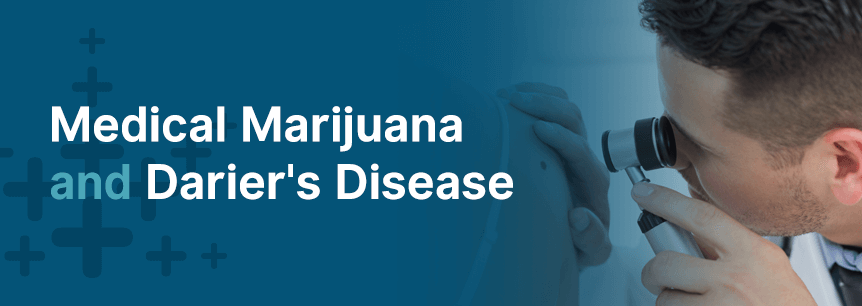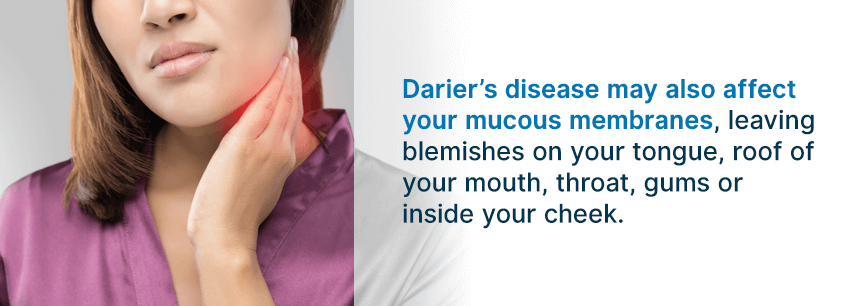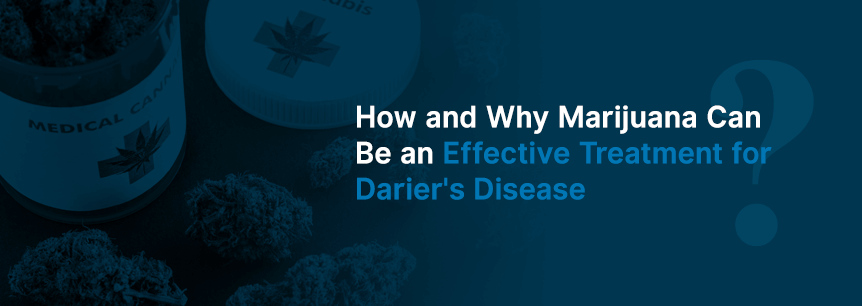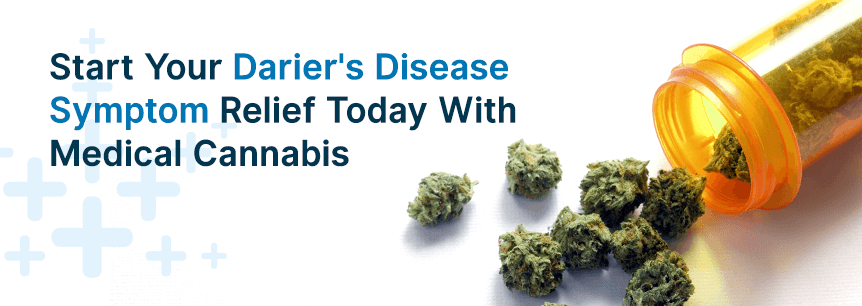
Darier’s disease, which is often referred to as DD or DAR, can result in skin lesions and so much more. If you have the condition, you may also have to deal with pain, inflammation, sleeping problems and more. On top of this, the medications your doctor prescribes may come with their own set of undesirable side effects. Medical marijuana and how it can play into Darier’s disease treatment is something researchers and doctors are studying with promising, positive results.
DD is a skin disorder characterized by skin lesions or wart-like blemishes on the body. These blemishes are often:
Common areas of your body where you may get these blemishes include:
DD’s characteristic wart-like blemishes typically come on in later childhood or early adulthood. The disease’s severity varies with time, and affected individuals experience periods of flare-ups or periods of fewer blemishes. Darier’s disease is often chronic and might worsen with age.
Environmental factors may influence the appearance of blemishes. For instance, many individuals with Darier’s disease experience more blemishes in the summer when exposed to humidity and heat. Other factors that can increase the occurrence of blemishes are:
Occasionally, those with DD might have neurological disorders such as epilepsy and mild intellectual disability. People have also reported behavior and learning difficulties. Researchers don’t know if these disorders link to genetic changes leading to Darier’s disease, or if it’s just coincidence. Some researchers think behavioral problems may be associated with social stigma those with many skin blemishes experience.
Blemishes on localized skin areas characterize a segmental or linear form of DD. Some individuals with the linear type of DD experience nail abnormalities many see in classic Darier’s disease, but these only show up on one side of the body.
Symptoms of DD vary between people. Some have very mild forms that are asymptomatic, and it takes careful inspection to identify them. Other people have extensive lesions, causing substantial distress. The severity of sufferers’ symptoms and their condition may fluctuate over time.
One characteristic of the skin lesions is greasy, persistent, scaly papules. These skin lesions may affect various sites, including:
The papules have a harsh, firm texture similar to coarse sandpaper. They may be yellow-brown, light or brown. When smaller papules begin growing together, they might form bigger warty lesions, potentially producing a bad odor inside the skin folds. They may resemble seborrhoeic dermatitis with a heavily crusted rash.
Darier’s disease may also affect your mucous membranes, leaving blemishes on your tongue, roof of your mouth, throat, gums or inside your cheek. The condition can also cause other features, such as nail abnormalities, irregular textured nails, white or red streaks in your nails or small pits on the soles of your feet or palms of your hands.

Atypical DD presentations are common and are:
Cystic acne, a severe skin condition involving painful nodules, also links with DD in some people.
Darier disease is a dominantly inherited disorder affecting the nails, skin, and mucosae. Skin signs tend to develop between the ages of six and 20, according to the Journal of the Royal Society of Medicine (JRSM), although you may not notice the lesions until you aggravate them by sweating or exposing them to heat or sunlight.
Greasy, firm skin-colored papules form the warty lesion. They attack the seborrhoeic areas of the face and trunk predominantly. Itching pruritus often occurs, affecting around 80 percent of patients. While pain is unusual, the itching can cause discomfort. A common complication is a secondary infection of skin lesions.
As mentioned before, some individuals with DD also suffer from neurological conditions like depression. A study published in the British Journal of Dermatology (BJD) evaluating 100 participants with neuropsychiatric disorders who also had DD showed patients had high lifetime rates of mood disorders, such as:
This suggests a possible genetic link in all of them. The study noted that these rates occur more highly than with the general population.
According to Dermatology Advisor, facts about Darier’s disease include:
The origins of Darier’s disease date back to the 18th century when Ferdinand-Jean Darier and James Clarke White first reported the disease in 1889 independently. White, the first American to become a professor of dermatology, recognized DD’s genetic nature first. He noticed it affected both a daughter and mother. Darier, who was a French physician, dermatologist and pathologist, also discovered other diseases, including follicular keratosis, and he conducted a lot of research on leprosy and tuberculosis, too.
Physicians often use genetic testing to assess which ichthyosis (a type of genetic skin disorder) an individual has. By doing this, it could help the doctor determine your Darier’s disease treatment and management.
Another reason behind genetic testing is if you or one of your family members wants to have children. Doctors would ideally perform genetic testing first on the individual with ichthyosis, which often helps them determine an individual’s or relative’s likelihood of having children with ichthyosis. Genetic test results rarely predict the severity of a condition in any person, even when they can identify a certain mutation.
Darier’s disease can cause discomfort as well as embarrassment for those whose lesions are noticeable on exposed parts of their bodies. Some basic measures of managing DD might include:
You can reduce scaling by using moisturizers with lactic or urea acid. A topical steroid with low or mild potency can be useful to address inflammation.
The skin affected might have an unpleasant odor due to the rash having bacteria growth. If the doctor suspects bacterial overgrowth or if they notice a lot of crusting, they may recommend soaking in astringents or applying antiseptics.
Oral retinoids are effective DD treatments. But when you use them for a long time, they can come with serious side effects, and doctors need to monitor people using these medications closely. Once retinoid therapy stops, the symptoms of DD will return. Topical retinoids like isotretinoin are effective for some people. Common side effects of retinoids include:
Other treatments may include oral antibiotics to clear bacterial infection. These may cause side effects such as:
Oral acyclovir is a medication for treating or suppressing herpes simplex virus infection. Side effects may include:
Other types of treatment may include electrosurgery, dermabrasion or Mohs micrographic surgery, the latter of which is often used for those who suffer from skin cancer. The procedure involves removing thin layers of the affected area until the surgeon believes they have excised most of the lesion.
In May 2018, researchers began conducting a randomized, placebo-controlled study of the efficacy and safety of LX3305 — a Sphingosine-1-Phosphate Lyase Inhibitor — for DD treatment. This trial is still in process.

Medical marijuana can be a great treatment option for those who suffer from Darier’s disease. Cannabinoids may attenuate allergic responses, blocking CB2 receptors in the skin to lead to a decrease in inflammation of the epidermis.
Patients who have reactions similar to eczema see well-tolerated results and alleviation of the scratching and uncomfortable feeling associated with it. There is also exceptional evidence cannabinoids may be able to inhibit malignant tumors; however synthetic cannabinoids that are more potent than THC have only proven more effective.
The CBD in cannabis eliminates some of the body’s allergic responses to DD by blocking the skin’s CB2 receptors. This leads to much less itching and inflammation. It’s also a far better alternative to regular steroid use.
Marijuana for Darier’s disease is a great alternative to topical steroid creams which often come with harsh side effects. Medical weed is good for skin inflammation and irritation, since it’s extremely beneficial and therapeutic as an anti-inflammatory. A patient’s CB2 receptors in their epidermis show a positive reaction to cannabinoids, leaving skin improved and feeling healthy.
Some of the symptoms cannabis for Darier’s disease can assist with alleviating include:
Combining cannabis and Darier’s disease treatment also can help lessen the side effects associated with medications used to control the condition. These include:
Medical pot for inflammation effectively reduces chronic inflammation and inflammatory-related pain because of its two main cannabinoids — THC and CBDv. Another marijuana compound, beta-caryophyllene, affects your CB2 receptor. A study in 2008 showed a 70 percent swelling reduction in mice given oral beta-caryophyllene doses. The mice that didn’t have the CB2 receptor showed no improvement.
Pot’s cannabinoids react with your body’s endocannabinoid receptors. A few of these receptors impact your mood directly. Therefore, using a cannabis product can alleviate depression and enhance your mood. And, if you’re experiencing mild depression as a symptom of your DD, medical pot may help.
For centuries, individuals have been using marijuana to treat their depression. It enhances your mood and provides you with energy. People also use marijuana to treat debilitating disorders like HIV and cancer. Patients suffering from these conditions often experience depression while undergoing treatment. Cannabis helps them cope with their depressive feelings.

The body naturally makes some cannabinoids, called endocannabinoids. Your endocannabinoids support various body functions like:
They play an important role in providing internal stability and keeping you healthy. Your body’s naturally occurring chemicals expedite cell communication. Endocannabinoid problems can manifest into physical issues because of your body’s imbalance.
When you receive your marijuana treatment, you’ll need to decide on a strain to best aid you with your health needs. Each cannabis strain provides distinctive effects, and as long as you consult with a doctor and do your research, you can shop for marijuana products to suit your specific needs.
When selecting your meds, pick a strain that meets your health needs. You shouldn’t just get any kind of strain of marijuana — each one has unique effects. Talk to your doctor and dispensary to find out what type you should look for. These are a few good strains for fighting various symptoms of Darier’s disease:
Each delivery method of cannabis affects you differently, and many factors determine the proper treatment for you. Some methods of medical cannabis for those with Darier’s disease include:
If you’re struggling with DD and you’re not finding relief from your current treatment, you might want to think about purchasing CBD oil. While this oil doesn’t necessarily cure the disorder, it can help relieve your symptoms. It can lower your inflammation, ensuring you’re not constantly itchy and thereby scratching your skin. It also promotes an all-over-body calm.
Marijuana treatment takes experimentation. Experimenting with different strains and methods of use is one of the simplest ways to find the right cannabis treatment for your particular case.

If you’re struggling with Darier’s disease, use the resources from Marijuana Doctors to obtain more information and begin your search for a cannabis doctor.
Locating a good dispensary and finding a qualified cannabis doctor will allow you to begin your medical marijuana treatment plan. An experienced cannabis doctor will provide you with a recommendation for treatment and point you in the right direction on where to start. Dispensary staff has experience and knowledge to help you with your product selections. Soon you will get the relief you seek from this often-aggravating condition.
Find A Doctor Find A Dispensary